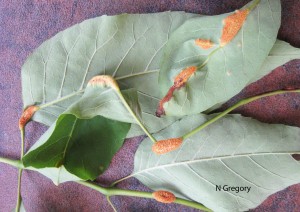Phytophthora root rot, a soil borne disease caused by a fungus-like organism, is a widespread problem which can affect many of our woody and herbaceous landscape plants. Azaleas, hollies, and rhododendron are probably the most frequently affected plant group in the landscape, especially in wet soils. Submit a sample including roots to the Plant Diagnostic Clinic and we can confirm what the problem is. Don't continue replanting with susceptible hosts. Increase drainage and plant a more resistant shrub or tree. The best control for Phytophthora is to avoid getting it started in the first place. Phytophthora is favored by planting susceptible species and cultivars in poorly drained soils, or by overwatering even in sites with adequate drainage. Once a Phytophthora problem is established in a landscape site, the best option is probably to remove the affected plants and replace with resistant species. Some possibilities include Ilex glabra (inkberry holly), Clethra alnifolia (summersweet), Itea sp (sweetspire), Physocarpus opufoliius (Eastern ninebark), and Leucothoe fontanesiana. Examples suggested by extension agents in North Carolina include nandina, Chinese holly (cultivars including 'Rotunda', 'Dwarf Burford' and 'Carissa'), liriope, Indian hawthorn, and Camellia sasanqua cultivars (Camellia japonica is susceptible). The rhododendron hybrids: Caroline, Martha Isaacson, Professor Hugo de Vries and Red Head are considered resistant. In addition, the azalea cultivars 'Formosa', 'Fred Cochran', 'Fakir' and 'Corrine Murrah' are considered highly resistant. Other resistant azalea cultivars include Rhododendron poukhanese, Formosa, Fakir and Corrine Murrah, 'Merlin', 'Hampton Beauty', 'Higasa', 'Pink Gumpo' and 'Delaware Valley'. Susceptible cultivars include 'White Gumpo', 'Hinodegiri', 'Hershey Red', 'Coral Bells', 'Pink Pearl' and 'Hino Crimson'. Susceptible cultivars are also among the most widely planted. Camellia sasanqua is resistant to root rot while C. japonica is highly susceptible. Keep in mind that resistant hybrids are not immune. Chemical control is generally not practical for the homeowner, and involves a drench or injection by a certified applicator.
NFG 7/1/2013
 Christmas Tree Planting Tips
Christmas Tree Planting Tips






